For the 20th anniversary of the James Cameron classic Terminator 2, Judgment Day a reposting of the Personal Canon essay on the film, easily one of the best actioners of all time with a performance by Linda Hamilton which rivals Sigourney Weaver's Ripley badassery ...and that's a nearly impossible feat.
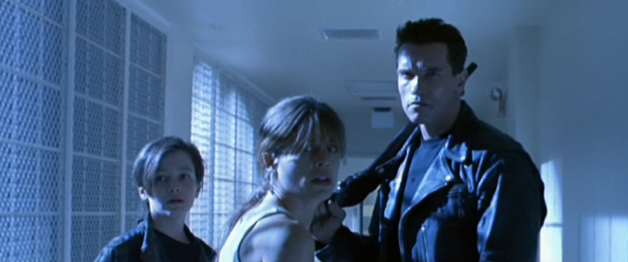
T2: Judgment Day (1991) Directed by James Cameron | Screenplay by James Cameron and William Wisher Jr | Starring: Arnold Schwarzenegger, Linda Hamilton, Robert Patrick, Joe Morton, S Epatha Merkerson and introducing Edward Furlong | Released 07/03/1991
Once the big profits for the small budgeted The Terminator began rolling in in October of '84, James Cameron became a hot commodity. He wasted no time on the follow up. Twenty-one months later the release of the much larger sci-fi spectacle Aliens (1986 -- to be celebrated here very soon) catapulted him from "filmmaker to watch" to the real deal. His long absence from the multiplex -- Avatar's December 2009 bow ended a 12 year drought -- made it easy to forget this basic truth: the director once moved swiftly through the stages of filmmaking if never quite as rapidly as his movies moved through their action. After Aliens, he left outer space for the deep seas with The Abyss (another hit) and having proved himself thrice over, returned to the killer robots that made his name.
"Model Citizen"
The Terminator cost 6 million to make, Terminator 2: Judgment Day would cost 100 million plus. The budget wasn't the only thing exploding: salaries, visual effects, setpieces, ambition, and public reaction were all supersized. Yet for all of this exponential external growth, Cameron smartly kept his focus tight and intimate.
 Early shots give you the color scheme: fiery reds|steel blues. (Michael Edwards as JC.)
Early shots give you the color scheme: fiery reds|steel blues. (Michael Edwards as JC.)
Sarah Connor's opening narration and the imagery of post-apocalyptic LA it plays over, both review the first movie and download Cameron's game plan for the sequel.
The computer which controlled the machines, Skynet, sent two terminators back through time. Their mission: to destroy the leader of the human resistance, John Connor my son. The first terminator was programmed to strike at me in the year 1984 before John was born. It failed. The second was set to strike at John himself when he was still a child. As before the resistance was able to send a lone warrior, a protector for John. It was just a question of which one of them would reach him first.
In other words, it's more of the same... only bigger which we notice immediately by way of shinier effects and massive fireball explosions. This repeat template is familiar but it won't be comfortable. We're also going deeper. The story structure is varied only enough to reflect the passage of time. But what has that passage of time wrought?
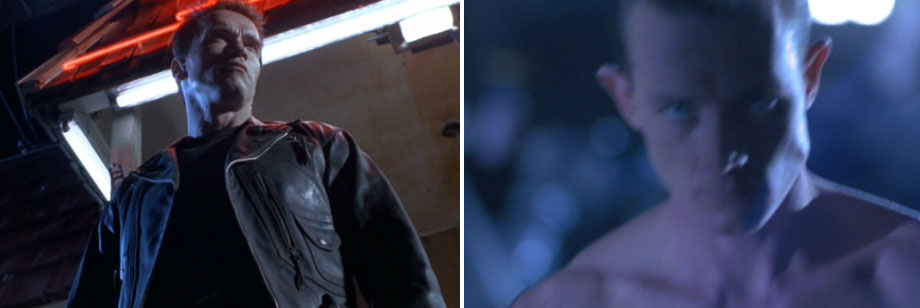 Upgrade U: The origin T-800 (Arnold) and the leaner meaner T-1000 (Robert Patrick)
Upgrade U: The origin T-800 (Arnold) and the leaner meaner T-1000 (Robert Patrick)
As before... two naked men arriving from the future are introduced first. Once clothes are violently procured, their target is immediately identified by text (a phone book in the first film, a police car monitor in the second). Cut to target: John Connor (Edward Furlong). He's even introduced with a shot of a motorbike just like his mother was in 1984. So far so remarkably similar. This makes the slight tweaks stand out all the more. First, the film is more self consciously "funny" (the "Born to Be Bad" accompaniment to the T-800's intro). Second, both visitors from the future are instantly portrayed as formidable threats rather than as a David and Goliath mismatch. Third... where the hell is Sarah Connor?
 "Sarah Connor Doesn't Live Here Anymore" Meet the lean mean T-91 (Linda Hamilton)
"Sarah Connor Doesn't Live Here Anymore" Meet the lean mean T-91 (Linda Hamilton)
Ah, there she is!
She's locked up in a mental hospital cuz she crazy... she batshit crazy.
...the usual indicators: depression, anxiety, violent acting out, delusions of persecution. The delusional architecture is fairly unique.
See, Sarah can't shut up about everyone dying and the killer robots. No one, not even her son John, shipped off to foster care, believes her.
If The Terminator (1984) were a debut album, it'd be beloved by rock purists and critics for its raw recorded-in-a-garage honesty. Terminator 2: Judgment Day (1991) is, then, its polished recorded-in-a-studio follow up. With its new moralizing and corny humor it might have been come across as something of a sellout were it not for the astonishing transformation of Linda Hamilton. Whatever savagery the franchise lost with the addition of a snarky pre-adolescent and new sense of humor was regained in Sarah's evolution. Few performers in cinema history have had an opportunity like this. Or, rather, few performers have made this much of their second stab at a character. She's unrecognizable and not just from the new musculature. Her endoskeleton, if you will, has morphed in the years inbetween the movies. Hamilton seems to have devoured every relentless droning beat from the first film and metastasized it for the new Sarah. Her awful knowledge of impending doom and long years of isolation have eaten her alive from the inside.
In one of the movie's earliest and most fascinating sequences, she tries to fool her psychiatrist into believing she's had a sudden change of heart. It's a simple enough scene on the page but onscreen it multiplies in complexity. The cameras varying points of view end up reflecting both Sarah's changes and the franchise's preoccupation with time travel. We're essentially watching a calm present tense Sarah watch past tense Sarah frothing at the mouth about doomsday while wordlessly strategizing a future escape. Simultaneously her smarmy psychiatrist is watching these competing versions of Sarah and correctly seeing them as the same: calm or wild, past or present she's only ever mentally locked up in the future.
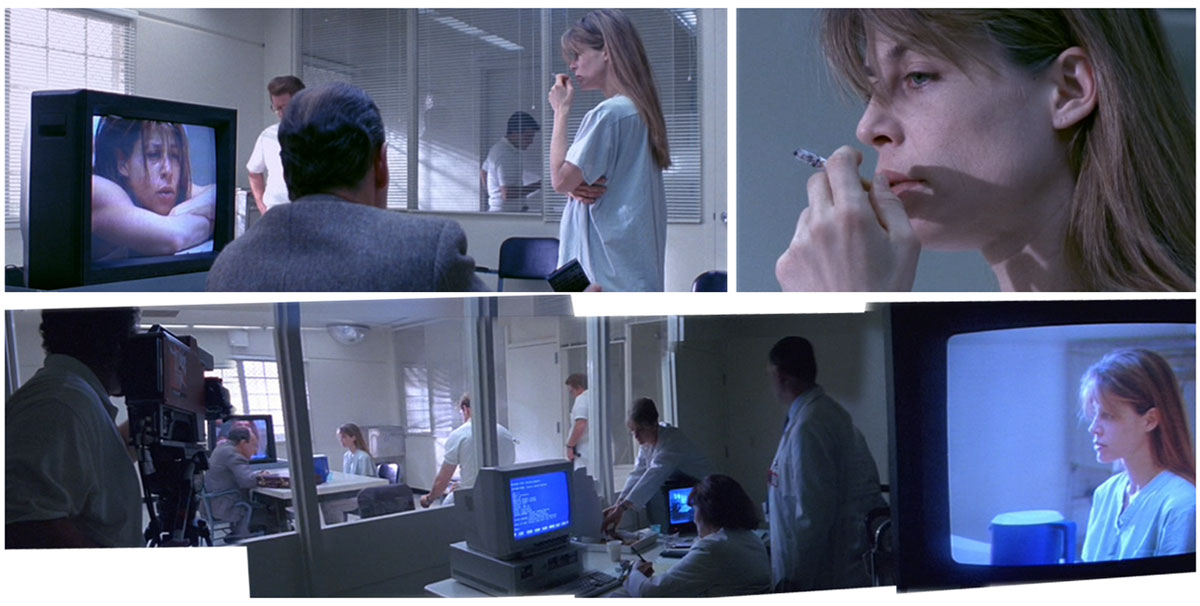
If that weren't heady enough, our view then widens tilting slightly to the left and then pans and slowly zooms out to the right (I've smooshed it all together for you above). It does all of this very calmly until what we're looking at is a whole roomful of people watching present Sarah watching past Sarah whilst being recorded (another past to study in another future!). This is the best part: to complete its quest to take everything in, the camera slowly zooms back in on yet another monitor of present tense Sarah (located to the far right); We're now a few layers removed from the physical present Sarah, and the past Sarah we once knew is has become an abstraction; new Sarah is a shell who happens to be playing a shell game.
When she realizes she's lost the game, her calm facade shatters and she attacks the psychiatrist. The camera, formerly serene observant, crashes back in on the action again. The guards have pinned Sarah down. The rescued psychiatrist turns to the camera within the camera to deliver the completely unfunny punchline.
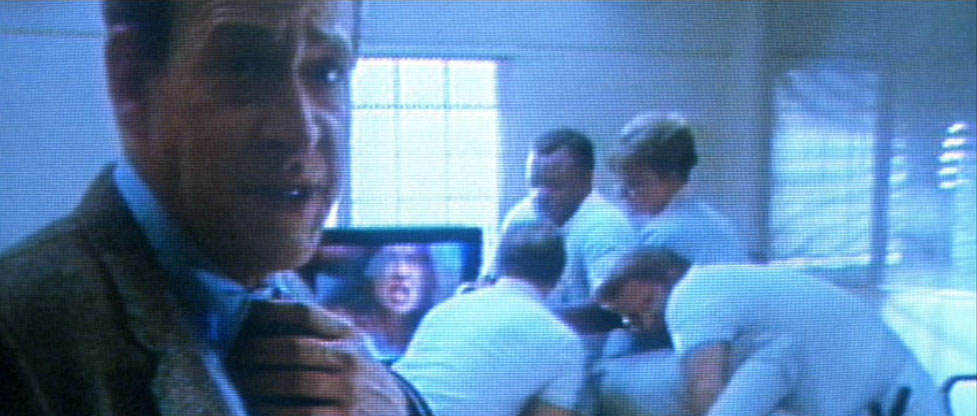
Model Citizen."
He may be an asshole but, you know, he's right about Sarah. Her present and past have merged again. Note how snarling Past Sarah presides over thrashing Present Sarah. Past or present, this woman is only ever a ball of fury hurtling towards a future oblivion that she alone is privy to. The one thing she is no longer is the waitress we once knew. It's a bold but authentic feeling reinvention of the character and the movie sells it for all it's worth.
Now that the unfamiliar new Sarah has the audience on edge, it's time for the film's first real action sequence. In keeping with the sequel's more mainstream tone, the collision of the two future warriors with their unsuspecting target (one aiming to kill, the other to protect) happens in a brightly lit mall rather than a dark night club. Cameron's skills with action have only grown from 1984 to 1991. Some action movies grind to a halt for their setpieces in the way that weaker musicals sometimes trip up on that "we're going to start singing now" pause. Cameron's action is always organic. He builds tension and dread from each scene until the setpieces burst out of the narrative like some H.R. Giger alien exploding from its human host.

Another remarkable thing about Cameron's gift for action direction is how much he's able to cram into the showstoppers without weighing them down or causing visual clutter. There's wordless exposition like the slow reveal of the T-1000's powers (a little bit more each battle... even the malfunctions in the last battle are shown rather than told), funny asides like the T-1000's wary glance at a doppelganger mannequin and even fun subliminal set design -- I've never noticed this before but the video game signs framing John Connor when his friend warns him about "the cop" (i.e. the T-1000) looking for him read "RESCUE" and "CAUTION". Most importantly, the action scenes display major invention during their requisite stunts, thrills and scares. Much of this emanates from the absolutely genius villain that Cameron has concocted in the T-1000. Even the way the actor Robert Patrick rounds corners or adjusts his walking or running speed is both freakishly menacing and wildly entertaining.
To continue the musical simile, let's just say that the action scenes have so many flourishes and movements that they're just like orchestral pieces or maybe pop songs. Consider the mall sequence: It has an opening verse (interior foot chase), repeated chorus (T-800 vs. T-1000's short bouts of gun play) a catchy bridge (the parking lot chase) and a second verse (exterior vehicular chase).
 Mall surveillance photos supercharge Sarah's escape plans. If her psychiatrist doesn't cooperate he's getting a liquid rooter injection.
Mall surveillance photos supercharge Sarah's escape plans. If her psychiatrist doesn't cooperate he's getting a liquid rooter injection.
No sooner does that "pop song" end than we launch into a veritable symphony at Pescadero. This entire sequence, from Sarah's brutal hostage-taking through the T-1000's ultra alarming shape shifting (that floor move -- sick!) to the final escape is genius. The transcendent peak comes with the oddly horrifying reunion between the T-800 and his former target (We know that the T-800 is now a good guy but she doesn't. And Hamilton has sucked us into Sarah's hair wire personality so vividly, we're both scared of her, for her and with her throughout) and then the collision of all four principles. All three heroes are finally stopped in their tracks, face to face with the T-1000 who walks liquidly through the bars separating them, only to be stopped momentarily by his non-liquid gun which has audibly caught on the bars. It's a wonderfully dischordant idiosyncratic note and we've reached lift off. Terminator 2 rockets from great action movie to great cinema, period. Right there.
Does the movie ever come back down again? Not really.

There are two breaks in action: First, a trip into the desert for healing and weapon acquisition and the second, a talky planning and exposition scene. In these two sequences we ponder the film's famous message "no fate but what we make" and its moralizing philosophy (the human race is self destructive). Neither of these "breaks" derail the movie's exquisite sense of danger. Sarah Connor carries it with her.
In her sad, furious and failed assassination attempt on Miles Dyson (Joe Morton) -- she knows his future scientific breakthroughs will lead to doomsday -- the film reveals its master stroke: T2 has not two terminators but three. Sarah has gone from hunted to hunter. The film even borrows and perverts 1984's sickening moment when Sarah Connor had a red target light on her forehead. This time she's the one training the deadly red dot on an innocent man, execution style.
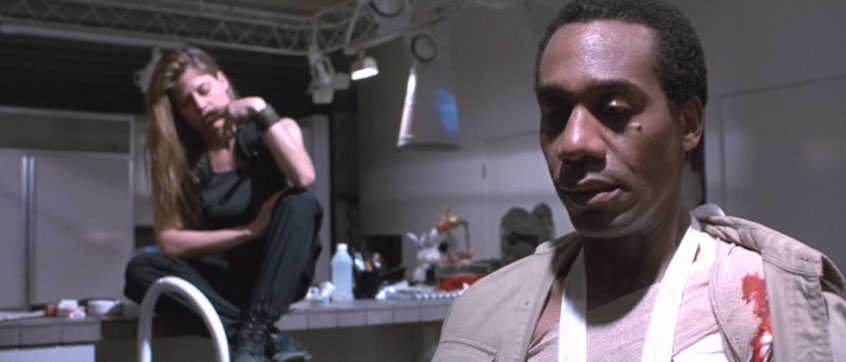 Mother superior (Hamilton) and the Father who doesn't know best (Joe Morton)
Mother superior (Hamilton) and the Father who doesn't know best (Joe Morton)
Cameron is savvy enough in his direction to let his heroine battering ram her way into unlikability and there's a pitch perfect moment of overkill with Sarah as moralizing hypocrite. She really can't help herself, she's so tightly wound.
Fucking men like you built the hydrogen bomb. Men like you... all you know how to create is death and destruction. You think you're so creative. You don't know what it's like to really create something, to create a life... to feel it growing inside you.
She knows from death and destruction herself and she's hardly been a model of matronly warmth even if she did give birth to our future savior. The punchline of the scene, John Connor shouting "MOooom!!!" in embarrassment and 'let's get back on track' pleading is perfectly timed. It cuts the tension just enough to allow the movie to pull back from its philosophies and ideas and put on its final battle gear.
The rest is an attack on the Cyberdyne corporation (which is holding the chips... literally) and a molten lava finish in a steel mill. It's all adrenaline, blood, explosions and deeply satisfying arias of action.
 One last reminder that the film has three Terminators as T-1000 morphs into Sarah Connor. That's not visual effects trickery, that's just Linda Hamilton's twin sister.
One last reminder that the film has three Terminators as T-1000 morphs into Sarah Connor. That's not visual effects trickery, that's just Linda Hamilton's twin sister.
Though T2 frequently references its predecessor it never rests on its laurels. It's a hard working piece of cinema. Respect came far more easily than it had to the original. It proved an immediate success with critics, audiences and even Oscar. The Academy usually has to warm up to genre fare and seven years of growing respect for the original killer robot sleeper did the trick. The sequel won four Oscars and even two additional tech nominations that are often reserved for Best Picture players (cinematography and film editing). Sadly, no prestigious honors happened for Linda Hamilton. It's a shame. Despite the revolution in visual effects swirling all around her, Sarah Connor's transformation gave T2's its enduring muscle and heart. Liquid metal was new and eye-popping in 1991 but nothing ever beats the timeless spectacle of flesh and blood.